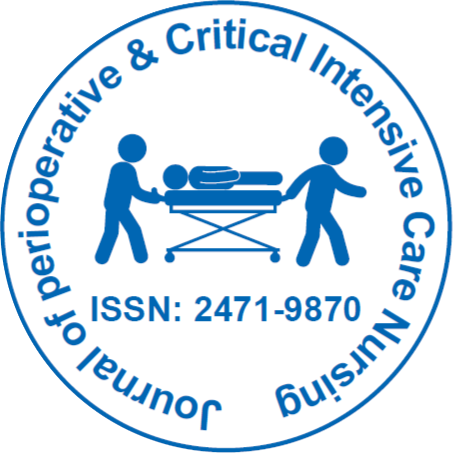
Journal of Perioperative & Critical Intensive Care Nursing
Open Access
ISSN: 2471-9870
+44-77-2385-9429

ISSN: 2471-9870
+44-77-2385-9429
Opinion Article - (2024)Volume 10, Issue 3
Anaesthesia management is an important aspect of modern surgical practice, encompassing the administration of medications and techniques to ensure patient comfort and safety during surgical procedures. It involves a comprehensive approach that not only focuses on pain relief but also considers the patient’s overall physiological state, potential risks and postoperative recovery. This article discusses about the key components of anaesthesia management, its types, challenges and the importance of a multidisciplinary approach in achieving optimal outcomes.
Types of anaesthesia
Anaesthesia is categorized into three main types: General, regional and local. General anaesthesia renders patient’s unconscious and insensible to pain throughout the surgery, typically administered through inhalation or intravenous methods. This type is commonly used for major surgeries, such as abdominal or orthopedic procedures. Regional anaesthesia, on the other hand, blocks sensation in specific areas of the body, such as during childbirth with epidurals or spinal blocks. Local anaesthesia numbs a small, specific area, often used for minor procedures like dental work or skin biopsies.
The choice of anaesthesia depends on several factors, including the type of surgery, patient health status and individual preferences. Anaesthesia providers must carefully evaluate these factors to determine the most appropriate method for each patient.
Preoperative assessment
A thorough preoperative assessment is vital for successful anaesthesia management. This process involves reviewing the patient’s medical history, conducting a physical examination and assessing any potential risks. Key considerations include previous anaesthesia experiences, allergies, current medications and underlying medical conditions, such as cardiovascular or respiratory diseases. This comprehensive evaluation allows anaesthesia providers to develop a tailored anesthetic plan that minimizes risks and addresses specific patient needs.
Effective communication with patients is also important during this phase. Educating patients about what to expect during and after the procedure can alleviate anxiety and improve compliance with preoperative instructions.
Intraoperative management
During surgery, the anaesthesia provider is responsible for monitoring the patient’s vital signs and adjusting the anesthetic as needed. Continuous assessment of parameters such as heart rate, blood pressure, oxygen saturation and respiratory rate is essential for ensuring patient safety. Anaesthesia machines and monitors provide real-time data that help the provider make informed decisions about the anesthetic depth and any necessary interventions.
The administration of anesthetic agents is carefully managed to maintain the desired level of anaesthesia while minimizing potential side effects. For example, fluctuations in blood pressure may require adjustments in fluid administration or medication dosages.
Postoperative care
Postoperative care is a important component of anaesthesia management, as it directly impacts patient recovery. Following surgery, patients are typically transferred to a recovery area where their vital signs and overall status are closely monitored. The anaesthesia provider continues to assess the patient’s response to anaesthesia and manages any postoperative pain or nausea.
Effective pain management is essential for promoting recovery and enhancing patient satisfaction. This may involve the use of multimodal analgesia, combining different classes of pain medications to optimize pain control while minimizing side effects.
Challenges in anaesthesia management
Anaesthesia management is not without its challenges. Variability in patient responses to anesthetic agents can complicate the administration process. Additionally, unexpected complications, such as allergic reactions or adverse events, may arise during surgery. Anaesthesia providers must be well-prepared to handle these situations, employing essential thinking and advanced problem-solving skills to ensure patient safety.
Moreover, advancements in surgical techniques and technologies have led to increased complexity in anaesthesia management. As procedures become more intricate, anaesthesia providers must continuously update their knowledge and skills to navigate these challenges effectively. This adaptability is essential for ensuring optimal anaesthesia care and minimizing risks throughout the surgical experience.
In conclusion, anaesthesia management is a vital aspect of patient care during surgical procedures. By employing a comprehensive approach that includes thorough preoperative assessments, vigilant intraoperative monitoring and effective postoperative care, anaesthesia providers can significantly enhance patient safety and comfort. Collaboration among the surgical team, ongoing education and a focus on patient-centered care are essential for achieving optimal outcomes in anaesthesia management. As the field continues to evolve, a steadfast commitment to excellence in anaesthesia practice will remain essential in delivering high-quality healthcare.
Citation: Batis M (2024). The Complexity of Anaesthesia: Strategies for Effective Patient Care and Management. J Perioper Crit Intensive Care Nurs. 10:262.
Received: 21-Aug-2024, Manuscript No. JPCIC-24-34556 ; Editor assigned: 23-Aug-2024, Pre QC No. JPCIC-24-34556 (PQ); Reviewed: 06-Sep-2024, QC No. JPCIC-24-34556 ; Revised: 13-Sep-2024, Manuscript No. JPCIC-24-34556 (R); Published: 20-Sep-2024 , DOI: 10.35248/2471-9870.24.10.262
Copyright: © 2024 Batis M. This is an open-access article distributed under the terms of the Creative Commons Attribution License, which permits unrestricted use, distribution, and reproduction in any medium, provided the original author and source are credited.